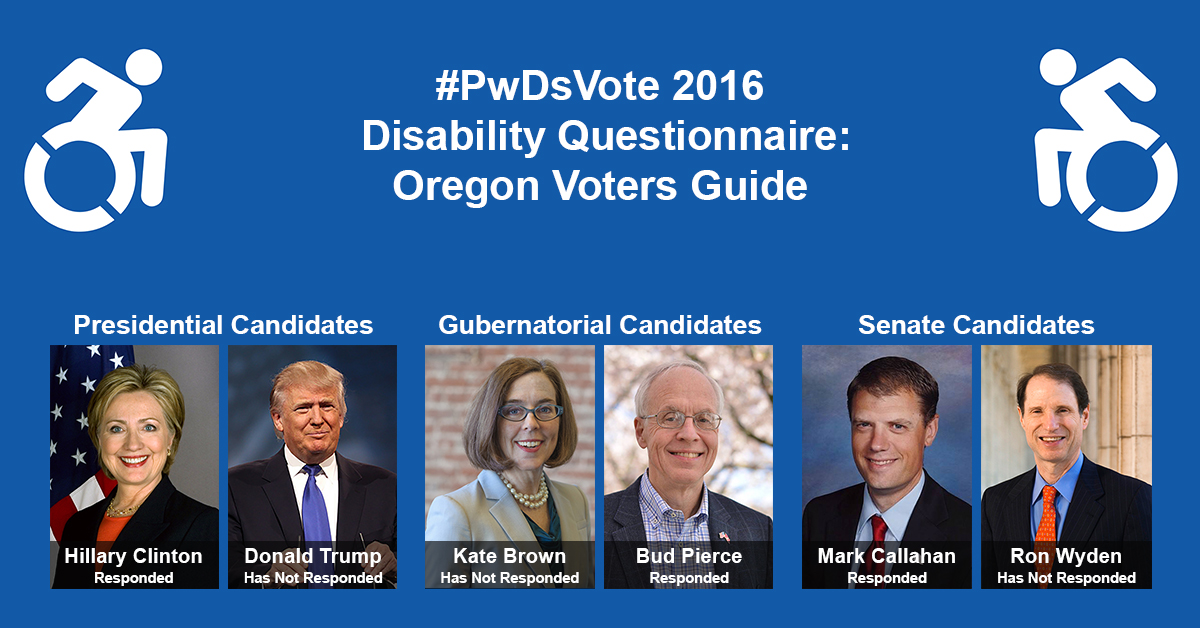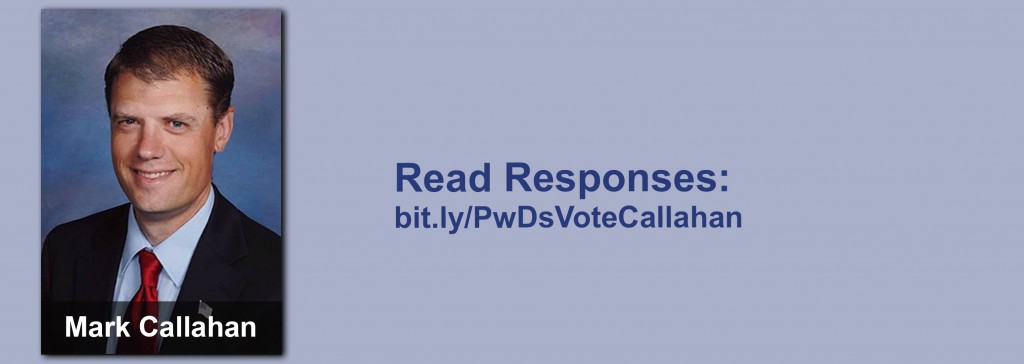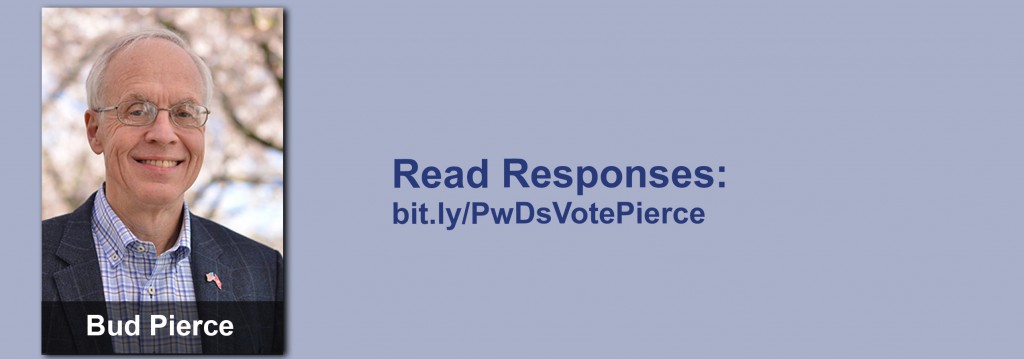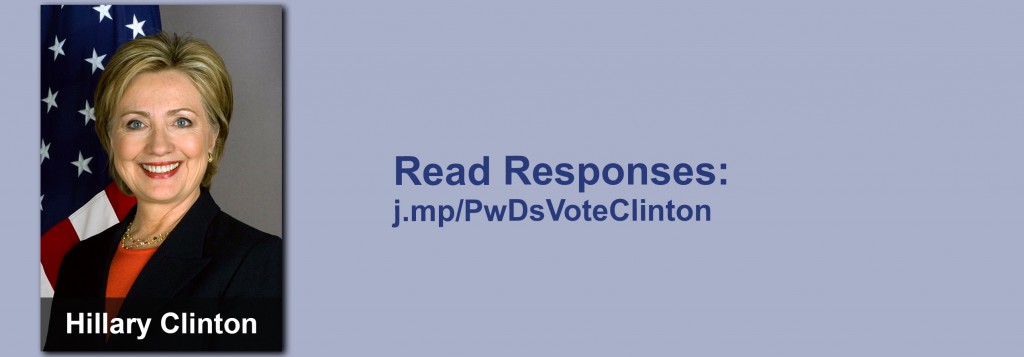Washington, Oct. 17 – As voters get ready to head to the polls in Oregon, RespectAbility has released its Oregon Disability Voter Guide for the upcoming senate, gubernatorial, and presidential races. Republicans Bud Pierce and Mark Callahan, who are challenging incumbent Democrats Kate Brown and Ron Wyden for governor and senator, as well as presidential candidate Hillary Clinton, have completed the #PwDsVote Disability Campaign Questionnaire for people with disabilities. Wyden and Brown have not yet responded to the questionnaire.
Twenty-six candidates for Senate, as well as eleven candidates for governor, from both sides of the aisle (22 Democrats, 14 Republicans, 1 Green Party) have responded with answers to the questionnaire so far, showing that disability rights is a nonpartisan issue. An additional nine candidates responded that they are not completing any questionnaires during this campaign season. The responses also are geographically-diverse, coming from states all around the country, as politicians are paying more and more attention to the disability community.
The #PwDsVote 2016 Campaign Questionnaires were designed by and for people with disabilities (PwDs) and those who love them to know where candidates stand on key issues. RespectAbility is nonpartisan and does not endorse candidates. The questionnaires are purely for educational purposes as voters go to the polls.
The presidential questionnaire was created during the primary season and asked all of the presidential candidates to comment on 16 disability questions. Former Secretary of State Hillary Clinton responded by addressing all of the questions. Despite numerous requests in person and by phone and email, the Trump campaign has not yet filled out the questionnaire. The American Association of People with Disabilities and the National Council on Independent Living also has a nonpartisan presidential questionnaire,which both Clinton and Trump have completed. Libertarian Gary Johnson and Green Party candidate Jill Stein have not filled out either questionnaire.
The down-ballot survey was adapted from the presidential questionnaire to ask gubernatorial candidates 16 questions and senatorial candidates 17 questions. All answers are posted verbatim and in full on The RespectAbility Report, a publication that covers the intersection of disability and politics.
Oregon’s 596,693 citizens with disabilities now have a chance to read Callahan’s and Pierce’s responses and understand where they lie on certain issues. RespectAbility is still awaiting responses from Kate Brown and Ron Wyden and will publish them verbatim if and when they are received.
Oregon ranks 24th in the nation for employment of people with disabilities as 36.4 percent of the working-age people with disabilities in Oregon have a job. However, there is still work to be done to improve outcomes for people with disabilities. The upcoming elections and the implementation of the Workforce Innovation and Opportunity Act (WIOA) will continue to increase opportunities and employment for people with disabilities, and voters need to know where candidates stand on the issues.
In his response, Pierce talked about how his work as a doctor helped inform him on the needs of people with disabilities.
“More than anything else, I believe in the dignity of work for all Oregonians. Having work to do, and access to basic health care services, are the major social determinants of health,” he responded. “All Oregonians, with or without disabilities, should have access to no/low cost education/training to improve their opportunities for work.”
Callahan spoke about how his campaign manager, who has a disability, has helped shape his campaign’s attitude of being inclusive of people with disabilities.
“My campaign manager, Narlina, has discussed with me her own experiences regarding her being disabled and being judged because of it, and her inability to convince employers she is able to do some work,” he said. “My interactions with Narlina’s handicapped son has shown me how with the proper education, encouragement, and support system he will be able to have a job and live his adult life with limited assistance. I believe all disabled American’s deserve a chance to have these same opportunities.”
Narlina Duke, who first went on medical disability in 2004 and was diagnosed with a rare terminal illness in 2013, also submitted a statement. An edited shorter version is included here, but the entire statement is posted online:

“Prior to becoming disabled, I had worked one to two jobs at a time, while volunteering within the community. I spent the first two years of my disability moving to different states, and trying to convince employers to hire me. I would get to the interview, only to be informed that my health was too much of a question, and be denied for the job. Working for Mark Callahan has provided me a joy I cannot explain properly in words. He has accommodated my own health needs, as well as my autistic son’s. I am sharing all of this with you because despite being someone who is permanently disabled with an illness they say is terminal, I am more than capable of contributing to society. Politics have provided me an outlet that allows me to also accommodate my own health needs. Politics have provided me a way to stand up for what I believe in.”
Fully one-out-of-five voters have a disability, and 52 percent of likely voters have a loved one with a disability. Only 34 percent of working-age Americans with disabilities nationally have jobs, despite the fact that the vast majority want to work. More than 11 million working age people with disabilities are now living on government benefits in our country.
RespectAbility President Jennifer Laszlo Mizrahi said, “It is vital for us to know where the candidates stand on the disability aspects of economic, stigma, education, safety, transportation, housing, healthcare, foreign affairs, criminal justice and other issues. Candidates have hugely different ideas about how to deal with the issues. Thus, it’s extremely important to read their full answers so you can understand their vast differences. We also are disappointed that Mr. Trump, Gov. Brown and Sen. Wyden have yet to complete the questionnaire and hope they will do so soon. We will send out any updates that arrive.”
According to a new report from Rutgers University, 35.4 million people with disabilities will be eligible to vote in the November 2016 elections, representing close to one-sixth of the total electorate. That’s an increase of nearly 11 percent since 2008.
Oregon Transparent with Employment Legislation
There are 316,222 Oregonians with disabilities who are between the ages of 18-64. Additionally, there are 14,000 Oregonians ages 16-20 with disabilities. More than 72,000 Oregon students have individual education plans (IEPs). However, some Oregon children with disabilities may not yet have received a disability diagnosis they need, and thus are not yet receiving the school accommodations and supports that they need to succeed. This can lead to a lifetime of poverty or flowing down the school to prison pipeline.
Oregon is in the top 25 states when it comes to the employment of people with disabilities. There are over 316,000 people with disabilities between the ages of 18 to 64 in Oregon and 36.4 percent of them are employed. While this makes Oregon number twenty-four amongst states, there is still a 38.5-point gap when you consider the 74.9 percent of people without disabilities in Oregon who are working. Additionally, each year a quarter of the youth ages 16-20 in Oregon will age out of school and because of your state’s hard work, they have increasing chances to find success in the working world.
RespectAbility, founded in 2013, is a nonpartisan, nonprofit organization working to end stigmas and advance opportunities for people with disabilities. It has submitted comments for all 50 state’s drafts of the Unified Plan as required under Section 102 of WIOA. Oregon’s commitment to people with disabilities is evident throughout the written state plan. Oregon also has been notably transparent in regards to their WIOA changes. Upon submitting RespectAbility’s comments concerning the state plan, Oregon responded with a template of their own which addresses the comments made not only by RespectAbility, but all other organizations and individuals that submitted comments. Because of WIOA, Oregon has the chance to institutionalize and expand on the many best practices you have already propelled in gaining high rates in terms of employment outcomes for people with disabilities.
One of the most important facets of WIOA is that it raises expectations for youth with disabilities and assists states to provide them with the supports they need to ensure success. Indeed, as Oregon’s Baby Boomers retire and the state’s economy evolves, employers are starting to experience increasing talent shortage. Oregonians with disabilities are an untapped resource that can be trained to bridge that gap. Indeed, a recent detailed study by the Kessler Foundation and the University of New Hampshire shows the 70 percent of working age people with disabilities are striving for work.
Evidence shows that people with disabilities can provide a wonderful solution to companies and other employers that want to succeed. The diverse skills, greater loyalty and higher retention rates of people with disabilities are already starting to meet employer talent needs in increasing numbers around America. With WIOA, Oregon can benefit from that progress if it truly breaks down silos within government agencies and partners, and lets innovation, based on evidence-based practices, take place.
However, the gap in the labor force participation between people with and without disabilities is still too large around the entire country. This lack of employment for people with disabilities creates poverty, powerlessness, and poor health. Polls and studies show that people with disabilities want the opportunity to have the dignity and independence that jobs provide.
America has 1.2 million youth with disabilities, between the ages of 16 and 20. Each year 300,000 of them age into what should be the workforce, but stigmas and lack of knowledge about the capabilities of people with disabilities means that most do not find employers willing to hire them. Young adults with disabilities in all of these states are hoping to find work. They have high expectations and deserve the opportunity to achieve the American dream. Young people with disabilities may simply need some thoughtful help to transition into the workforce. See data on all 50 states here: State Data.
Remember to Vote
Oregon residents can vote for the candidates of their choice either on the standard voting schedule or through voting by mail and absentee ballots. Oregonians have until Oct. 18, 2016, to register to vote for the presidential general election. Register to vote online at: Online Voter Registration Application. More information regarding voting can be found at: Voting and Elections. If you are unable to partake in standard voting, any registered Oregon voter can submit their vote through the mail with absentee ballots. Registered voters receive a ballot two to three weeks before the election.
Voters also receive an official ballot to complete and insert into the security envelope which is placed in the ballot return envelope and signed by the voter. The ballot return envelope can be stamped and mailed or dropped off at any official drop box across the state. More information regarding voting by mail and absentee ballots can be found at: Voting in Oregon.









[…] the candidates’ positions on disability related topics. Resources like the nonpartisan Respectability Report’s Oregon Voter Guide and Disability Rights Oregon’s Easy Voting Guide are great places to […]